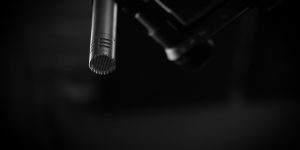Let’s keep things simple… We’re going to be looking at 2 of the best budget overhead microphones.
The microphones I’ve nominated for this position are the Samson C02 (what I currently use) and the RODE M5 pencil condenser microphones.
Pencil condenser microphones are usually the preferred choice for overheads.
However, you could technically use any type of microphone you want.
If you want to learn HOW to use a stereo pair of microphones though, check out THIS GUIDE.
For now, we’ll be focusing on two of my favourite overhead microphones…
- Should I use condenser or ribbon microphones for overheads?
- Samson C02 Pencil Condenser Microphones
- RODE M5 Pencil Condenser Microphones
- Samson C02 vs RODE M5
- Summary: 2 of the Best Budget Overhead Microphones
Should I use condenser or ribbon microphones for overheads?
If you know a thing or two about microphones, you’ll understand why I didn’t mention any ribbon microphones.
Ribbon microphones aren’t nearly as affordable, even the ones on THIS LIST.
However, it’s important to note that both condenser AND ribbon microphones can be used as overhead microphones. For example, The Beatles used ribbon microphones (The Coles 4038) for drum overheads.
Nowadays though, condenser microphones are usually the preferred choice.
Why’s that? Because of their BRIGHTNESS.
Sometimes condenser microphones can be too bright though which is why some people prefer the DARKER sound that ribbon microphones can provide.
Ribbon microphones are also less sensitive, so they’ll reject more ambient noise.
In retrospect though, you WILL capture more room sound since ribbon microphones are bi-directional. Condenser microphones are usually UNIDIRECTIONAL.
So, it just depends on what you want to do.
Take my word though, you’ll be much better off with a pair of condenser microphones for your overheads. They’ll be much more versatile and can be used elsewhere as well.
Also, you can always “darken” them up in post with EQ.
Samson C02 Pencil Condenser Microphones
Alright, we’re starting with my weapon of choice… The Samson C02s.
Sold as a matched pair, here’s what you can expect:
- Polar Pattern: Cardioid
- Frequency Response: 50 Hz – 20,000 Hz
- Maximum SPL: 134 dB
- Noise Floor: 22 dB
- Included Accessories: Carrying Case, Windshields, Shock-Mounts
- Warranty: 2 Years
If you’re planning on using these exclusively as overheads, they’re perfect.
The fact that the frequency response begins at 50 Hz will already cut-off some unnecessary frequencies in the low-end and save you some trouble in post-production.
However, this also means that the Samson C02s are less versatile.
That being said, I’ve also used them to record congas and acoustic guitar… They sound excellent for those applications, but you’ll lose some “warmth”.
The SPL tolerance is more than high enough to handle drums, so no worries about that!
The noise floor isn’t the best in the industry, but it’s still relatively low.
Now, what I like most about the Samson C02s is what’s included in the box. The protective carrying case is much appreciated and the shock-mount microphones clips are excellent tools for getting the most out of these two condensers right out of the box.
Remember, condenser microphones are VERY sensitive so good microphone clips/shock-mounts go a long way!
The included windshields aren’t as useful for overheads, but great if you want to record vocals.
RODE M5 Pencil Condenser Microphones
Next up, we’ve got the reliable RODE M5.
Also sold as a matched pair, here’s what it’s got under the hood:
- Polar Pattern: Cardioid
- Frequency Response: 20 Hz – 20,000 Hz
- Maximum SPL: 140 dB
- Noise Floor: 19 dB
- Included Accessories: Windshields, Microphone Clips
- Warranty: 10 Years
The first thing you’ll notice is that the RODE M5s have an extended frequency response.
In other words, these condenser microphones cover the full spectrum of our hearing. That’s what makes me prefer the M5s for an all-around solution.
To be honest, I kind of wish I had gone with these instead!
The slightly higher SPL tolerance doesn’t make that much of a difference, but the RODE M5s are also slightly less noisy than the Samson C02s.
However, I feel like RODE has cut an important corner in regards to accessories.
First of all, I would’ve appreciated a storage case.
Secondly, the microphone clips get the job done, but you’ll probably want something better (like a shock-mounted clip) especially if you’re mounting these near drums.
In regards to warranty though, nobody can beat the 10-year RODE warranty.
Samson C02 vs RODE M5
Want to compare these microphones side-by-side? Check this table out!
| Samson C02 | RODE M5 | |
| Polar Pattern | Cardioid | Cardioid |
| Frequency Response | 50 – 20,000 Hz | 20 – 20,000 Hz |
| Maximum SPL | 134 dB | 140 dB |
| Noise Floor | 22 dB | 19 dB |
| Included Accessores | Protective Case, Shock-Mount Clips, Windshield | Microphone Clips, Windshields |
| Warranty | 2 Years | 10 Years |
Although the Samson C02s and RODE M5s are intended for the same use, they’re actually somewhat different.
The frequency response is the most important difference to note.
They’ll both sound great for overhead purposes, but if ever you want to experiment with different microphone placement techniques (such as “Recorder Man”), you’ll get more out of the M5s.
That’s because it’ll actually capture the full-range of your kick drum.
In other words, if you wanted to record your drum kit using ONLY two microphones, the RODE M5s would be best.
I know this from experience because I currently own the Samson C02s.
If you want more information on the two microphone drum configurations, READ THIS.
Summary: 2 of the Best Budget Overhead Microphones
So, who’s the winner in your book?
Maybe you think there’s another microphone that should’ve made this list…
Either way, I’m curious to know what your thoughts are!
Which of these two microphones (or other) are you leaning towards and why?
As I mentioned, I think both of these microphones sound great for different applications, but the best choice for an all-around solution would definitely be the RODE M5.
Frequency response is important, but you also need to keep TONE in mind.
Maybe you actually prefer the sound of the Samson C02, but need more range.
It’s always a difficult decision when it comes to sound, but the best way to start understanding the differences is by purchasing some microphones and putting them to good use.
You can always sell/trade them once you find out what you like!
So, if you have any questions or need any assistance finding a microphone… Leave me a comment!
Thanks for reading, until next time!
Sources:
http://www.samsontech.com/samson/products/microphones/condenser-microphones/c02/
http://www.rode.com/microphones/m5










2 thoughts on “2 Best Budget Overhead Microphones”
Thanks for your information re M5 and CO 2.
What I really want to buy is a microphone to record a number of persons, with the mic placed high on a stand to cover them all, i.e. a choir, especially in a church. Recording direct instruments overhead is not my interest or need.
What are your suggestions about this please?
Regards
Joe
Hey Joe,
What you need in this case is either a large-diaphragm condenser with a cardioid polar pattern or an omni-directional mic.
You could also purchase a portable handy recorder like the Zoom H6 and use the XY mic and/or Mid-Side mic attachmentns.
Here are some links to those…
– Zoom H6 Review
– Multi-pattern mic
Hope that helps, thanks for reaching out!
– Stefan